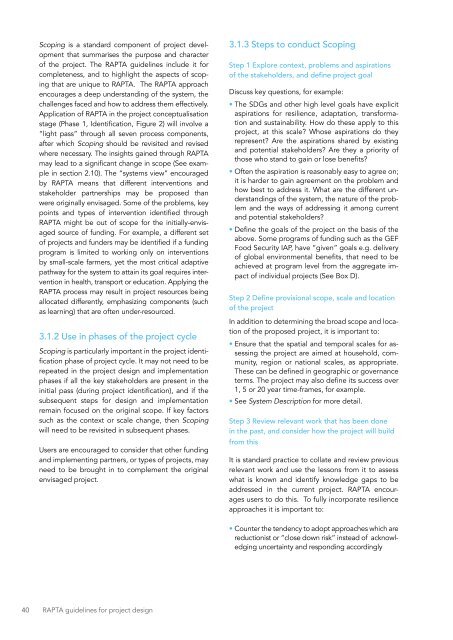DESIGNING PROJECTS IN A RAPIDLY CHANGING WORLD
srun3013fp1
srun3013fp1
Create successful ePaper yourself
Turn your PDF publications into a flip-book with our unique Google optimized e-Paper software.
Scoping is a standard component of project development<br />
that summarises the purpose and character<br />
of the project. The RAPTA guidelines include it for<br />
completeness, and to highlight the aspects of scoping<br />
that are unique to RAPTA. The RAPTA approach<br />
encourages a deep understanding of the system, the<br />
challenges faced and how to address them effectively.<br />
Application of RAPTA in the project conceptualisation<br />
stage (Phase 1, Identification, Figure 2) will involve a<br />
“light pass” through all seven process components,<br />
after which Scoping should be revisited and revised<br />
where necessary. The insights gained through RAPTA<br />
may lead to a significant change in scope (See example<br />
in section 2.10). The “systems view” encouraged<br />
by RAPTA means that different interventions and<br />
stakeholder partnerships may be proposed than<br />
were originally envisaged. Some of the problems, key<br />
points and types of intervention identified through<br />
RAPTA might be out of scope for the initially-envisaged<br />
source of funding. For example, a different set<br />
of projects and funders may be identified if a funding<br />
program is limited to working only on interventions<br />
by small-scale farmers, yet the most critical adaptive<br />
pathway for the system to attain its goal requires intervention<br />
in health, transport or education. Applying the<br />
RAPTA process may result in project resources being<br />
allocated differently, emphasizing components (such<br />
as learning) that are often under-resourced.<br />
3.1.2 Use in phases of the project cycle<br />
Scoping is particularly important in the project identification<br />
phase of project cycle. It may not need to be<br />
repeated in the project design and implementation<br />
phases if all the key stakeholders are present in the<br />
initial pass (during project identification), and if the<br />
subsequent steps for design and implementation<br />
remain focused on the original scope. If key factors<br />
such as the context or scale change, then Scoping<br />
will need to be revisited in subsequent phases.<br />
Users are encouraged to consider that other funding<br />
and implementing partners, or types of projects, may<br />
need to be brought in to complement the original<br />
envisaged project.<br />
3.1.3 Steps to conduct Scoping<br />
Step 1 Explore context, problems and aspirations<br />
of the stakeholders, and define project goal<br />
Discuss key questions, for example:<br />
• The SDGs and other high level goals have explicit<br />
aspirations for resilience, adaptation, transformation<br />
and sustainability. How do these apply to this<br />
project, at this scale? Whose aspirations do they<br />
represent? Are the aspirations shared by existing<br />
and potential stakeholders? Are they a priority of<br />
those who stand to gain or lose benefits?<br />
• Often the aspiration is reasonably easy to agree on;<br />
it is harder to gain agreement on the problem and<br />
how best to address it. What are the different understandings<br />
of the system, the nature of the problem<br />
and the ways of addressing it among current<br />
and potential stakeholders?<br />
• Define the goals of the project on the basis of the<br />
above. Some programs of funding such as the GEF<br />
Food Security IAP, have “given” goals e.g. delivery<br />
of global environmental benefits, that need to be<br />
achieved at program level from the aggregate impact<br />
of individual projects (See Box D).<br />
Step 2 Define provisional scope, scale and location<br />
of the project<br />
In addition to determining the broad scope and location<br />
of the proposed project, it is important to:<br />
• Ensure that the spatial and temporal scales for assessing<br />
the project are aimed at household, community,<br />
region or national scales, as appropriate.<br />
These can be defined in geographic or governance<br />
terms. The project may also define its success over<br />
1, 5 or 20 year time-frames, for example.<br />
• See System Description for more detail.<br />
Step 3 Review relevant work that has been done<br />
in the past, and consider how the project will build<br />
from this<br />
It is standard practice to collate and review previous<br />
relevant work and use the lessons from it to assess<br />
what is known and identify knowledge gaps to be<br />
addressed in the current project. RAPTA encourages<br />
users to do this. To fully incorporate resilience<br />
approaches it is important to:<br />
• Counter the tendency to adopt approaches which are<br />
reductionist or “close down risk” instead of acknowledging<br />
uncertainty and responding accordingly<br />
40 RAPTA guidelines for project design


